Understanding Crash Certifications: A Crash Course
This page was written to give a brief overview on all the different crash ratings available and what they mean. With all the different standards and terminology used over the years, it is easy to quickly become confused. We hope that this page will tread light on the history of ratings in the United States and what they are and what the terminology means.
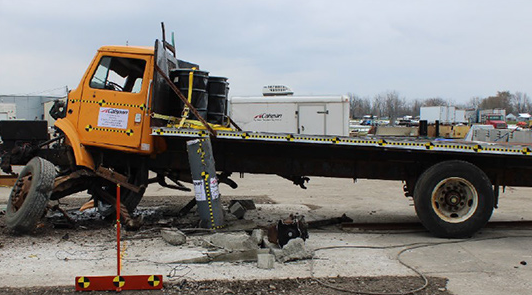
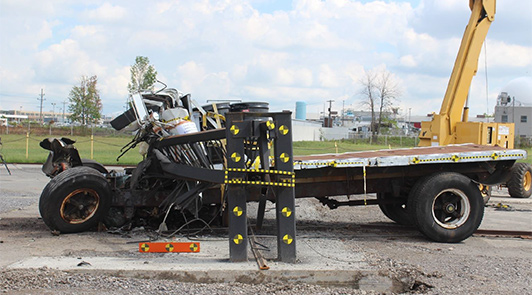
First Published Barrier Standard Rating
The first barrier rating standard published was by the US Department of State (DOS). This standard was published as SD-STD-02.01 Certification Standard: Test Method for Vehicle Crash Testing of Perimeter Barriers and Gates. This standard was published in April 1985.
Under this system the impact designations were as follows:
- K12 = Medium Duty Truck 15,000 lbs. (6,800kg) @ 50mph (80kph)
- K8 = Medium Duty Truck 15,000 lbs. (6,800kg) @ 40mph (65kph)
- K4 = Medium Duty Truck 15,000 lbs. (6,800kg) @ 30mph (50kph)
Along with the impact designation there was a penetration designation with this standard that correlated to the following under the 1985 test method:
- L3 ≤ 1 meter (3.3 ft)
- L2 ≤ 6 meters (20 ft)
- L1 ≤ 15 meters (50 ft)
Every barrier tested and certified to SD-STD-02.01, 1985 has a K and L rating associated with it.
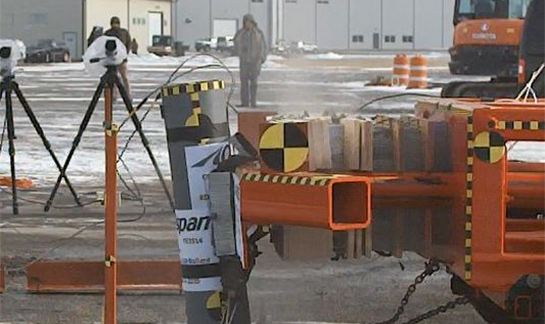
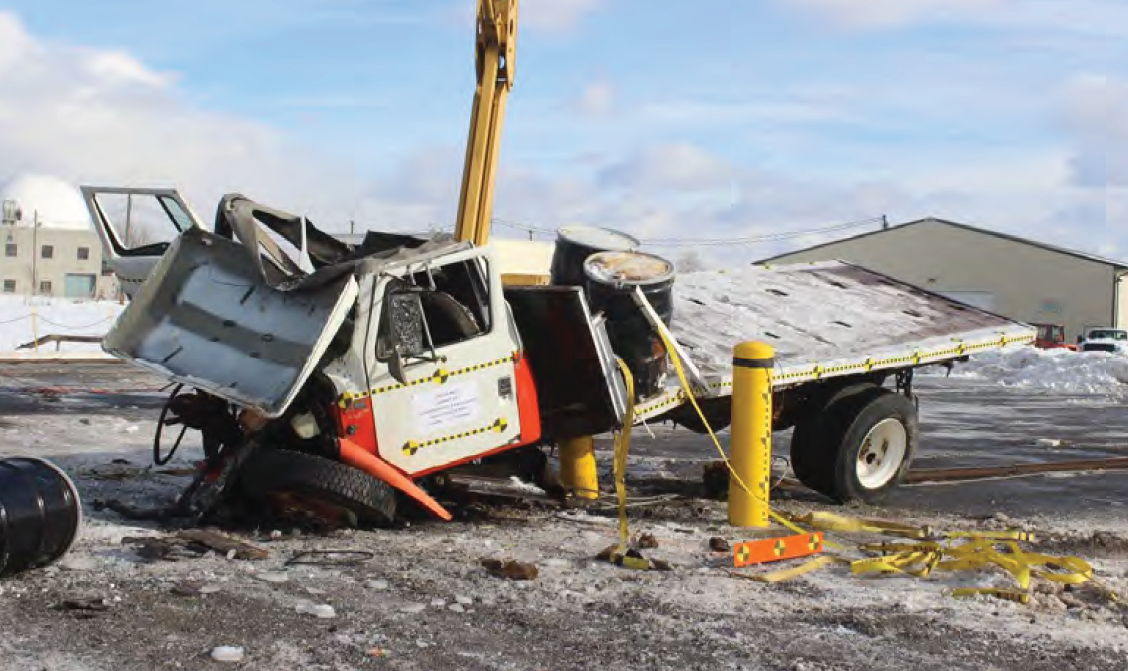
Standard Rating Revision
In 2003, the DOS test standard was revised in SD-STD-02.01, Revision A, Certification Standard: Test Method for Vehicle Crash Testing of Perimeters and Gates. This revised standard was published in March 2003. The major change from the original 1985 standard was that they removed the L-ratings on penetration and DOS would only accept barriers that met an L3 under the 1985 standard. This standard also went from a measuring point on the vehicle of the front bumper to the leading edge of the medium-duty truck bed.
Now, under the 2003 revision the impact designations were as follows:
- K12 = Medium Duty Truck 15,000 lbs. (6,800kg) @ 50mph (80kph) ≤ 1 meter (3.28 ft.) of penetration.
- K8 = Medium Duty Truck 15,000 lbs. (6,800kg) @ 40mph (65kph) ≤ 1 meter (3.28 ft.) of penetration.
- K4 = Medium Duty Truck 15,000lbs. (6,800kg) @ 30mph (50kph) ≤ 1 meter (3.28 ft.) of penetration.
This method was in place until ASTM developed a test standard published in August 2007. This was titled Standard Test Method for Vehicle Crash Testing of Perimeter Barriers, Designation F2656-07. It is important to note that under DOS and this ASTM F-2656-07 test standard, the measuring point for penetration is the leading edge of the truck bed, and the measuring point on the barrier is the backside of the barrier (non-impact side). Like the DOS test standard of 1985, ASTM utilized in impact designation and penetration designation. However, ASTM expanded into other vehicles other than the medium duty truck specified under the DOS test standards. There are also parameters to the year models that can be utilized and the masses of vehicles under ASTM. Occupant risk values under NCHRP Report 350 were also added. There are also requirements of the medium duty trucks used to have a certain gross vehicle mass rating, wheelbase, and flat bed length.
The following are the impact conditions under ASTM F2656-07:
- C40 = Small Passenger Car 2,430 lbs. (1,100kg) @ 40mph (65kph)
- C50 = Small Passenger Car 2,430 lbs. (1,100kg) @ 50mph (80kph)
- C60 = Small Passenger Car 2,430 lbs. (1,100kg) @ 60mph (100kph)
- PU40 = Pickup Truck 5,070 lbs. (2,300kg) @ 40mph (65kph)
- PU50 = Pickup Truck 5,070 lbs. (2,300kg) @ 50mph (80kph)
- PU60 = Pickup Truck 5,070 lbs. (2,300kg) @ 60mph (100kph)
- M30 = Medium Duty Truck 15,000 lbs. (6,800kg) @ 30mph (50kph)
- M40 = Medium Duty Truck 15,000 lbs. (6,800kg) @ 40mph (65kph)
- M50 = Medium Duty Truck 15,000 lbs. (6,800kg) @ 50mph (80kph)
- H30 = Heavy Goods Vehicle 65,000 lbs. (29,500kg) @ 30mph (50kph)
- H40 = Heavy Goods Vehicle 65,000 lbs. (29,500kg) @ 40mph (65kph)
- H50 = Heavy Goods Vehicle 65,000 lbs. (29,500kg) @ 50mph (80kph)
These impact conditions above are also given a dynamic penetration rating (P) that correlates with below:
- P1 ≤ 1 meter (3.3 ft)
- P2 = 1.01 meters (3.31 ft) to 7 meters (23.0 ft)
- P3 = 7.01 meters (23.01 ft) to 30 meters (98.4 ft)
- P4 = 30 meters (98.41 ft) or greater
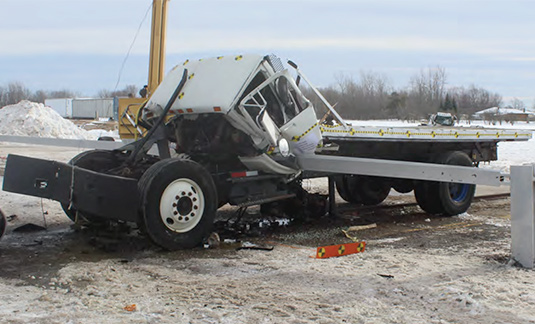
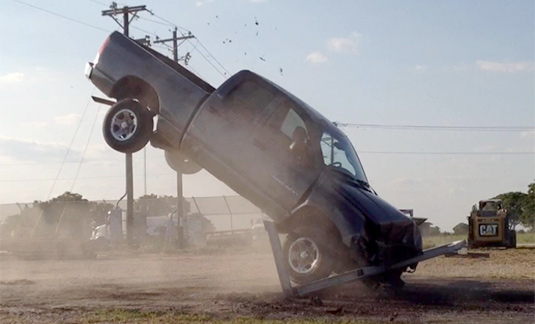
Standard for Perimeter Barrier Crash Testing
In July 2015, ASTM published the Standard Test Method for Vehicle Crash Testing of Perimeter Barriers, Designation F2656/F2656M-15. This version incorporated two additional vehicle types to the existing vehicles that were in ASTM F2656-07. The P4 penetration rating was removed from the 2015 standard and the small car and pickup were updated to the latest AASHTO Manual for Assessing Safety Hardware (MASH) the update to NCHRP Report 350.
The following are the impact conditions under ASTM F2656-15:
- SC30 = Small Passenger Car 2,430 lbs. (1,100kg) @ 30mph (50kph)
- SC40 = Small Passenger Car 2,430 lbs. (1,100kg) @ 40mph (65kph)
- SC50 = Small Passenger Car 2,430 lbs. (1,100kg) @ 50mph (80kph)
- SC60 = Small Passenger Car 2,430 lbs. (1,100kg) @ 60mph (100kph)
- FS30 = Full-Size Sedan 4,630 lbs. (2,100kg) @ 30 mph (50kph)
- FS40 = Full-Size Sedan 4,630 lbs. (2,100kg) @ 40 mph (65kph)
- FS50 = Full-Size Sedan 4,630 lbs. (2,100kg) @ 50 mph (80kph)
- FS60 = Full-Size Sedan 4,630 lbs. (2,100kg) @ 60 mph (100kph)
- PU30 = Pickup Truck 5,070 lbs. (2,300kg) @ 30mph (50kph)
- PU40 = Pickup Truck 5,070 lbs. (2,300kg) @ 40mph (65kph)
- PU50 = Pickup Truck 5,070 lbs. (2,300kg) @ 50mph (80kph)
- PU60 = Pickup Truck 5,070 lbs. (2,300kg) @ 60mph (100kph)
- M30 = Medium Duty Truck 15,000 lbs. (6,800kg) @ 30mph (50kph)
- M40 = Medium Duty Truck 15,000 lbs. (6,800kg) @ 40mph (65kph)
- M50 = Medium Duty Truck 15,000 lbs. (6,800kg) @ 50mph (80kph)
- C730 = Class 7 Cabover 15,873 lbs. (7,200kg) @ 30mph (50kph)
- C740 = Class 7 Cabover 15,873 lbs. (7,200kg) @ 40mph (65kph)
- C750 = Class 7 Cabover 15,873 lbs. (7,200kg) @ 50 mph (80kph)
- H30 = Heavy Goods Vehicle 65,000 lbs. (29,500kg) @ 30mph (50kph)
- H40 = Heavy Goods Vehicle 65,000 lbs. (29,500kg) @ 40mph (65kph)
- H50 = Heavy Goods Vehicle 65,000 lbs. (29,500kg) @ 50mph (80kph)
These impact conditions above are also given a dynamic penetration rating (P) that correlates with below:
- P1 ≤ 1 meter (3.3 ft)
- P2 = 1.01 meters (3.31 ft) to 7 meters (23.0 ft)
- P3 = 7.01 meters (23.01 ft) to 30 meters (98.4 ft)
- P4 penetration rating was removed from ASTM F2656-15 and is no longer an allowed rating under the standard.
ASTM F2656/2656M Revisions
In February 2018, ASTM published ASTM F2656/F2656M-18. The major change to this standard was moving the reference point of the barrier to the leading edge of the impacted side of the barrier versus the backside of the barrier. There was also a change in the number of shear plates required on the bed of the truck as keeping the bed secured to the truck during testing allowed for the greatest amount of force on the barrier. Shortly after this version was approved and published there was a revision and ASTM published ASTM F2656/F2656-18a which essentially changed everything back to ASTM F2656-15.
In April 2020, ASTM published ASTM F2656/2656M-20. This standard again changed the reference point back to the leading edge of the barrier, increased the shear plates needed for the bed attachment and brought items in to sync with ISO IWA 14-1. This will require those installing barriers to note that it will take some time for new barriers to meet the -20 certification requirements and that ASTM certifications on the medium duty truck will no longer align to K-ratings under DOS. We go into further detail on this further into the write up.
ISO IWA 14-1 and PAS 68 are two standards heavily used in European countries. It is important to note that many of the vehicles utilized for overseas testing are lower center of gravity and not readily available in the United States. When looking at the test performances you will see that under ASTM in the United States it is a taller truck where a motor is in the front of the vehicle. Most European crash tests you see a cabover style vehicle where there is no motor in front and the vehicle is lower to the ground. This is all noted as you want to be sure to put a barrier in the ground that has been tested to the vehicle types in your area or region that will meet or exceed them.
Another standard that Gibraltar tests to is ASTM F3016/F3016M-19. In September 2019, ASTM published the Standard Test Method for Surrogate Testing of Vehicle Impact Protective Devices at Low Speeds, Designation F3016/F3016M-19. This standard was designed to use a surrogate vehicle so you could run multiple low speed tests without the extreme costs of traditional testing to ASTM F2656 standards. This standard was designed for the surrogate vehicle to have the same characteristics of a full size pickup truck at 10mph – 30mph. However, the penetration requirements are much stricter as for a P1 rating no part of system or vehicle can penetrate more than 1 foot, otherwise it is a P2 and over 4 ft is a failure.
The impact conditions are as follows for ASTM F3016-19:
- S30 = Surrogate Test Vehicle 5,000 lbs. (2,268kg) @ 30 mph (50kph)
- S20 = Surrogate Test Vehicle 5,000 lbs. (2,268kg) @ 20mph (35kph)
- S10 = Surrogate Test Vehicle 5,000 lbs. (2,268kg) @ 10 mph (20kph)
Penetration Designations are as follows:
- P1 ≤ 1 ft. (0.30m)
- P2 ≤ 1.01 ft – 4 ft (0.31m-1.22m)
- FAILURE ≥ 4 ft (1.23m)
Understanding crash ratings can be confusing so be sure to also confirm with the manufacturer what exactly you are getting. Many products simply are marketed as crash tested, engineered, crash certified, etc. Make sure you know exactly what you are getting as there are many products that may not meet the needs of your site due to the penetration they allow. As a rule the following below tend to be where we see most issues when specifying projects.
Review
As a review, for vehicle barriers in general, it is important to know the following:
- What is the threat vehicle? Small Car, SUV, Truck, Medium Duty Flatbed This will determine what vehicle you need to be protected from.
- What is the speed the threat vehicle can get up to?
- Are there any direct points of impact or are the only points of impact at low degree angles? This will assist in determining the speed at which you need protection from.
- What is the standoff distance? There is no point in putting a P2 bollard on a sidewalk that is 20 ft. wide. A bollard with a P1 penetration rating will still intrude into the sidewalk by up to 10 ft – 11 ft at maximum penetration and can have the penetration certification of P1. This is due to the important fact that the measuring point on the truck is the leading edge of the truck bed.
- Is the product Engineered? Tested? Tested and Certified?
Products can be tested and have P3 or P4 penetrations, while this may be acceptable for portable barriers, it is not ideal for permanently installed barriers. Make sure that engineered products are being calculated off of an actual tested product that had been tested and certified in the past. We utilize 3rd party professional engineers to perform calculations and seal drawings when they are needed for unique installations in the field. Tested and Certified products are typically the most expensive, but you can rest assured you are getting a product you know will work.
If you or your firm has questions on crash certifications and what we offer in our barrier portfolio, please contact us today and a Gibraltar Perimeter Security representative will be in touch shortly!
References:
Anti-Ram Vehicle Barriers: Rating Systems – A Stone Engineering White Paper November 2, 2009
Certification Standard Test Method for Vehicle Crash Testing of Perimeter Barriers and Gates, SD-STD-02.01, Revision A, March 2003
ASTM F3016/3016M – 19 Standard Test Method for Surrogate Testing of Vehicle Impact Protective Devices at Low Speeds
ASTM F2656-07 Standard Test Method for Vehicle Crash Testing of Perimeter Barriers
ASTM F2656-15 Standard Test Method for Crash Testing of Vehicle Security Barriers
ASTM F2656-18 Standard Test Method for Crash Testing of Vehicle Security Barriers
ASTM F2656-18a Standard Test Method for Crash Testing of Vehicle Security Barriers
ASTM F2656-20 Standard Test Method for Crash Testing of Vehicle Security Barriers
